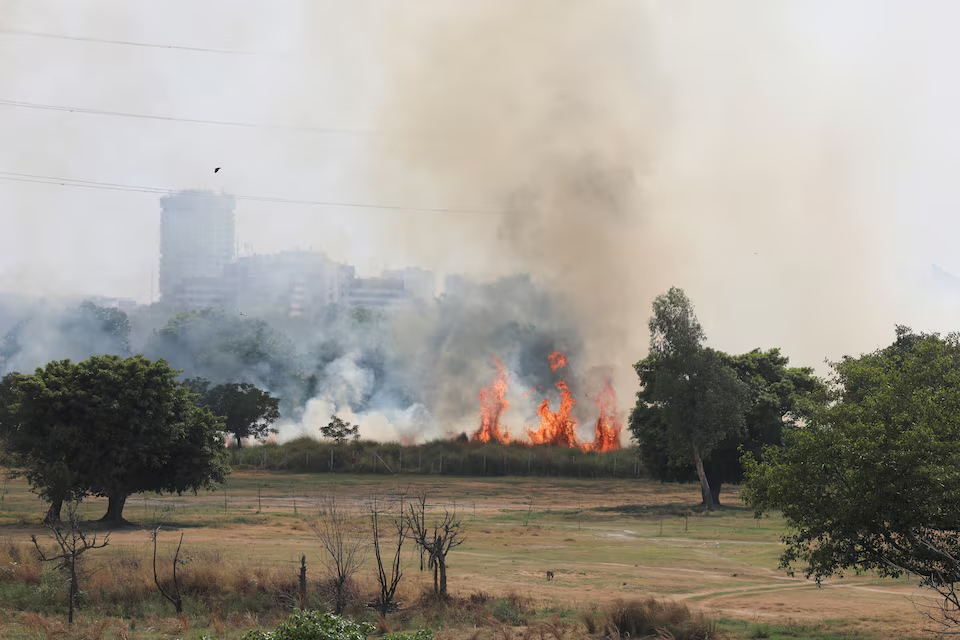Record temperatures in recent days are believed to be responsible for hundreds, even thousands, of deaths across Asia and Europe.
In Saudi Arabia, nearly 2 million Muslim pilgrims will complete the Hajj pilgrimage at the Grand Mosque in Mecca this week. But before the Hajj ends, hundreds have died while making the journey in temperatures above 51 degrees Celsius.
At least 530 Egyptians have died while participating in the Hajj, Egyptian health and security sources said on June 20, up from 307 previously reported. Another 40 people are still missing.

Fire burns in a field on a hot summer day in New Delhi, India, June 3. Photo: Reuters
Countries around the Mediterranean also endured another week of brutally high temperatures, contributing to wildfires from Portugal to Greece and along the northern African coast in Algeria, according to the US National Oceanic and Atmospheric Administration's Earth Observatory.
In Serbia, meteorologists predict temperatures will reach around 40 degrees Celsius this week as winds from North Africa blow a hot air mass across the Balkans. Health authorities have issued a red weather warning and advised people not to go outside.
The capital Belgrade's ambulance service said its doctors intervened 109 times in just one night to treat people with heart disease and chronic illnesses.
In neighboring Montenegro, where health authorities also warned people to stay in the shade until late afternoon, tens of thousands of tourists sought refreshments on beaches along the Adriatic coast. Meanwhile, scores of tourists died and went missing in the dangerous heat in Greece.
A large swath of the eastern United States is also languishing for the fourth straight day under a heat dome, a powerful high-pressure system that traps hot air over an area, preventing cooler air from penetrating and causing temperatures to soar on the ground. On June 20, the National Weather Service issued a heat warning for parts of Arizona like Phoenix, with temperatures expected to reach 115 degrees Fahrenheit.

Construction workers drink water during a heat wave affecting the northeastern United States, June 19. Photo: Reuters
New Delhi has had 38 consecutive days with maximum temperatures at or above 40 degrees Celsius since May 14, according to weather data. On June 19, an Indian health ministry official said there were more than 40,000 suspected cases of heatstroke and at least 110 deaths confirmed between March 1 and June 18, as northwest and eastern India recorded double the usual number of hot days in one of the country’s longest heatwaves.
The World Meteorological Organization says there is an 86% chance that one of the next five years will replace 2023 as the hottest year on record.
While global temperatures have overall risen by nearly 1.3 degrees Celsius above pre-industrial levels, climate change is creating more extreme temperature peaks, making heat waves more common, intense and longer lasting.
According to an international team of scientists from World Weather Attribution (WWA), on average globally, a heatwave that would have occurred once every 10 years in pre-industrial times will now occur 2.8 times in 10 years and temperatures will be 1.2 degrees Celsius hotter.
Scientists say heat waves will continue to increase if the world continues to emit climate-warming gases from burning fossil fuels. According to the WWA, if the world warms by 2 degrees Celsius, heat waves will occur 5.6 times every 10 years on average and be 2.6 degrees Celsius hotter.
Ngoc Anh (according to Reuters)
Source: https://www.congluan.vn/nang-nong-cuc-do-anh-huong-toi-nguoi-dan-tren-toan-the-gioi-post300201.html




































































































Comment (0)